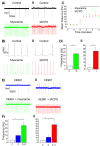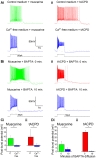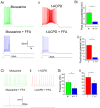Synergy of Glutamatergic and Cholinergic Modulation Induces Plateau Potentials in Hippocampal OLM Interneurons
- PMID: 31780902
- PMCID: PMC6861217
- DOI: 10.3389/fncel.2019.00508
Synergy of Glutamatergic and Cholinergic Modulation Induces Plateau Potentials in Hippocampal OLM Interneurons
Abstract
Oriens-lacunosum moleculare (OLM) cells are hippocampal inhibitory interneurons that are implicated in the regulation of information flow in the CA1 circuit, inhibiting cortical inputs to distal pyramidal cell dendrites, whilst disinhibiting CA3 inputs to pyramidal cells. OLM cells express metabotropic cholinergic (mAChR) and glutamatergic (mGluR) receptors, so modulation of these cells via these receptors may contribute to switching between functional modes of the hippocampus. Using a transgenic mouse line to identify OLM cells, we found that both mAChR and mGluR activation caused the cells to exhibit long-lasting depolarizing plateau potentials following evoked spike trains. Both mAChR- and mGluR-induced plateau potentials were eliminated by blocking transient receptor potential (TRP) channels, and were dependent on intracellular calcium concentration and calcium entry. Pharmacological tests indicated that Group I mGluRs are responsible for the glutamatergic induction of plateaus. There was also a pronounced synergy between the cholinergic and glutamatergic modulation, plateau potentials being generated by agonists applied together at concentrations too low to elicit any change when applied individually. This synergy could enable OLM cells to function as coincidence detectors of different neuromodulatory systems, leading to their enhanced and prolonged activation and a functional change in information flow within the hippocampus.
Keywords: OLM cells; TRP channel; interneuron; mAChR; mGluR; plateau potential; synergy.
Copyright © 2019 Hagger-Vaughan and Storm.
Figures






Similar articles
-
Deciphering how interneuron specific 3 cells control oriens lacunosum-moleculare cells to contribute to circuit function.J Neurophysiol. 2021 Oct 1;126(4):997-1014. doi: 10.1152/jn.00204.2021. Epub 2021 Aug 11. J Neurophysiol. 2021. PMID: 34379493
-
OLM interneurons differentially modulate CA3 and entorhinal inputs to hippocampal CA1 neurons.Nat Neurosci. 2012 Nov;15(11):1524-30. doi: 10.1038/nn.3235. Epub 2012 Oct 7. Nat Neurosci. 2012. PMID: 23042082 Free PMC article.
-
Dendritic inhibition provided by interneuron-specific cells controls the firing rate and timing of the hippocampal feedback inhibitory circuitry.J Neurosci. 2014 Mar 26;34(13):4534-47. doi: 10.1523/JNEUROSCI.3813-13.2014. J Neurosci. 2014. PMID: 24671999 Free PMC article.
-
Cholinergic Modulation of Dendritic Signaling in Hippocampal GABAergic Inhibitory Interneurons.Neuroscience. 2022 May 1;489:44-56. doi: 10.1016/j.neuroscience.2021.06.011. Epub 2021 Jun 12. Neuroscience. 2022. PMID: 34129910 Review.
-
Role of giant depolarizing potentials in shaping synaptic currents in the developing hippocampus.Crit Rev Neurobiol. 2006;18(1-2):13-23. doi: 10.1615/critrevneurobiol.v18.i1-2.30. Crit Rev Neurobiol. 2006. PMID: 17725505 Review.
Cited by
-
Nicotine-mediated activation of α2 nAChR-expressing OLM cells in developing mouse brains disrupts OLM cell-mediated control of LTP in adolescence.Neurobiol Learn Mem. 2022 Oct;194:107674. doi: 10.1016/j.nlm.2022.107674. Epub 2022 Aug 24. Neurobiol Learn Mem. 2022. PMID: 36029955 Free PMC article.
-
The Impact of Altered HCN1 Expression on Brain Function and Its Relationship with Epileptogenesis.Curr Neuropharmacol. 2023;21(10):2070-2078. doi: 10.2174/1570159X21666230214110333. Curr Neuropharmacol. 2023. PMID: 37366350 Free PMC article. Review.
-
Acetylcholine Boosts Dendritic NMDA Spikes in a CA3 Pyramidal Neuron Model.Neuroscience. 2022 May 1;489:69-83. doi: 10.1016/j.neuroscience.2021.11.014. Epub 2021 Nov 12. Neuroscience. 2022. PMID: 34780920 Free PMC article.
-
Effects of ketamine and propofol on muscarinic plateau potentials in rat neocortical pyramidal cells.PLoS One. 2025 Jan 2;20(1):e0316262. doi: 10.1371/journal.pone.0316262. eCollection 2025. PLoS One. 2025. PMID: 39746093 Free PMC article.
-
Non-apical plateau potentials and persistent firing induced by metabotropic cholinergic modulation in layer 2/3 pyramidal cells in the rat prefrontal cortex.PLoS One. 2024 Dec 10;19(12):e0314652. doi: 10.1371/journal.pone.0314652. eCollection 2024. PLoS One. 2024. PMID: 39656720 Free PMC article.
References
-
- Bocchio M., Lukacs I. P., Stacey R., Plaha P., Apostolopoulos V., Livermore L., et al. . (2019). Group II metabotropic glutamate receptors mediate presynaptic inhibition of excitatory transmission in pyramidal neurons of the human cerebral cortex. Front. Cell. Neurosci. 12:508. 10.3389/fncel.2018.00508 - DOI - PMC - PubMed
LinkOut - more resources
Full Text Sources
Molecular Biology Databases
Miscellaneous

